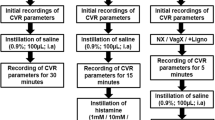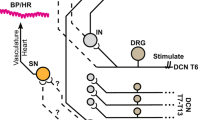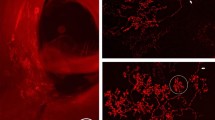Abstract
CHANGES in the calibre of vessels in the rabbit ear can be measured by a variety of methods. Assessment of the effect of various procedures on reflex vasomotor control requires direct stimulation of sympathetic nerves or ganglia, however, and is therefore unsuitable for unanaesthetized animals. It would be advantageous to induce predictable reflex vasomotor changes in intact animals which could be detected by a simple method. In man, reflex vasodilatation in the hand can be produced by heating the skin elsewhere1. This test depends on neural afferents from the heated area and sympathetic efferents to hand blood vessels and it has been used to measure autonomic function in diseases of the nervous system2. This test was adapted to the rabbit ear in order to investigate the effect on autonomic function produced by immunization with a variety of nervous antigens3. A diagrammatic representation of the test conditions is shown in Fig. 1. The animals were tested at constant environmental temperatures and silence was maintained throughout the procedure. To ensure that the rabbits were capable of vasodilatation at the time of the tests, 2 c.c. of 2 per cent procaine solution was injected subcutaneously around the base of the right ear. This produced vasomotor paralysis accompanied by a marked rise in temperature of the right ear. Reflex vasomotor changes in the left ear in response to heating the back for 40 sec were then monitored by thermocouples. When no vasodilatation occurred after the injection of local anaesthetic, tho animal was presumed fully vasodilated and not testable. A normal record is shown in Fig. 2. Heating the shaved back produces an initial vasoconstriction in the ear vessels, of varying magnitude, which lasts 2–10 sec. This gives way to a marked vasodilatation which outlasts the stimulus by 10–30 sec before returning to preheating levels. Irradiation of the back can be repeated at 1-min intervals. The vasodilatation is associated with ear temperature changes ranging from 0-4°–1° C. This vasodilatation is independent of the rate of heating and the threshold is at about 225 W. Pretreatment with atropine, 2 mg/kg, abolishes reflex vasodilatation and 0.8 mg/kg of eserine enhances it. The pathways involved in these vasomotor changes are not fully known. It has been shown by Holton and Rand4 that direct electrical stimulation of the superior cervical ganglion causes in rabbit ear vessels an initial vasoconstriction followed by vasodilatation and that the latter was abolished by atropine and enhanced by eserine. This vasodilator phase is presumably, therefore, due to postganglionic sympathetic cholinergic fibres. By analogy, brief heating of the back and direct electrical stimulation of the superior cervical ganglion utilize in the rabbit identical efferent pathways to the ear vessels. On the afferent side, heating the back produces its effect on ear blood flow probably by stimulation of receptors in the exposed skin rather than by warm blood. The short latency, the prompt return to baseline after cessation of the stimulus and the independence of the response on the rate of heating are all in keeping with this interpretation. This new test of vasomotor function in unanaesthetized rabbits was used in a large number of animals for a study of an experimental immunologically induced disorder of autonomic function.
This is a preview of subscription content, access via your institution
Access options
Subscribe to this journal
Receive 51 print issues and online access
$199.00 per year
only $3.90 per issue
Buy this article
- Purchase on Springer Link
- Instant access to full article PDF
Prices may be subject to local taxes which are calculated during checkout
Similar content being viewed by others
References
Kerslake, D. Mck., and Cooper, K. E., Clin. Sci., 9, 31 (1950).
Appenzeller, O., and Schnieden, H., Clin. Sci., 25, 413 (1963).
Appenzeller, O., Arnason, B. G., and Adams, R. D., J. Neurol. Neurosurg. Psychiat., 28, 510 (1965).
Holton, P., and Rand, M. J., Brit. J. Pharmacol., 19, 513 (1962).
Author information
Authors and Affiliations
Rights and permissions
About this article
Cite this article
APPENZELLER, O. Reflex Vascular Function in Unanaesthetized Rabbits. Nature 210, 1058–1059 (1966). https://doi.org/10.1038/2101058a0
Issue Date:
DOI: https://doi.org/10.1038/2101058a0
Comments
By submitting a comment you agree to abide by our Terms and Community Guidelines. If you find something abusive or that does not comply with our terms or guidelines please flag it as inappropriate.



